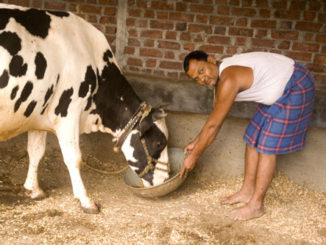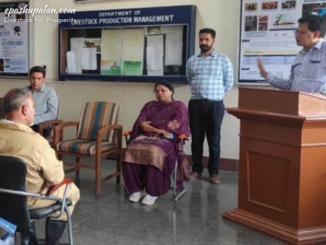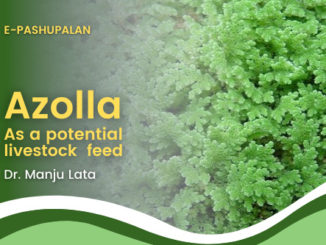Poultry farming practice of the nation has proved poultry birds, as one of the oldest, resource of food and wealth, to mankind. Also, poultry farming is contributing a greater fraction of animal husbandry sector to nation’s GDP. However, at the same time one can also can’t deny with the fact of higher susceptibility of poultry birds to various types of nutritional deficiency diseases.

These deficiency diseases affect the growth, hatchability, egg production of birds and ultimately the economic output of the farm. Both, fat-soluble vitamins and water-soluble vitamins deficiency (if occurred) may lead to occurrence of disease in poultry species. There are mainly four fat-soluble vitamins available as- Vitamin A, Vitamin-D, Vitamin E, Vitamin K. The vitamins along with their deficiency diseases in poultry birds are as following:
Vitamin A (RETINOL)
Vitamin-A was discovered by McCollum & Davis and Osborne & Mendel in the year, 1913 independently. Structurally, it is an unsaturated 20-Carbon cyclic alcohol consisting one beta-ionone ring. The rich sources of vitamin-A, may include carotenoids in plants; carrots; yellow maize; greens etc. Animal sources include esters like long chain retinyl esters, palmitate esters, while others comprising fish liver oils, egg yolk, butter, cream, liver, whole milk etc. The vitamin has many roles to play in physiology of body like its requirement for vision, proper bone growth, maintenance of mucus-secreting cells of epithelium etc.
Deficiency of Vitamin A causes many diseases in poultry birds’
Mostly, in adult poultry birds, nutritional deficiency of vitamin-A leads to “xeropthalmia” rather ‘nutritional roup’. This is characterized by mucopurulent rhinitis, occlusion of respiratory tract and keratomalacia due to dryness of tear glands. The discharge from eyes, leads to sticking together of eyelids. Respiration rate of the birds becomes rapid and difficult. In epithelial tissues layer keratinization occurs, from normal columnar to stratified squamous keratinizing epithelium, which further lowers the resistance to infections. Normal secretion and elimination of urine, is interfered so chances for formation of kidney and bladder stones also increases. Moreover, severe deficiency of the vitamin may lead to increase in blood uric acid from 5mg to 40mg per 100 ml blood. Urate deposits may also be observed on heart, pericardium, liver and spleen of the affected birds. Nervous signs include severe ataxia as first symptom in case of growing chicks ( which is different from ataxia caused due to deficiency of Vitamin-E). There is increase in cerebro-spinal fluid in vitamin-A deficient chicken. Reproductive performance of avian species, is also affected, as there occurs marked reduction in egg production and hatchability of fertile eggs. In case of breeders, there is failure to develop normal blood system in embryo and embryonic malposition may also be observed.
Vitamin D (Cholecalciferol)
McCollum in 1925 named an anti-rachitic factor as Vitamin D. Vitamin D is neither widely distributed nor present in active form even in plants. Hence, in order to meet the vitamin D requirements, fortified sources are used like irradiated yeast, irradiated milk , etc. The naturally occurring sources of vitamin D are of animal origin mainly like salt water fish (salmon, herring, sardines etc.), egg yolk, liver, butter milk, cream, cod-liver oil etc. However, sun cured hay and roughages, dead leaves of growing plants also contain vitamin D, as ergocalciferol. Chemically, ergosterol of plants and 7-dehydrocholestrol becomes active in presence of UV rays on conversion to ergocalciferol (D2) and cholecalciferol (D3). This active form of vitamin D (1, 25 dihydroxy-cholecalciferol) stimulates the synthesis of calcium binding protein, regulates calcium metabolism and skeletal remodeling. It also mobilizes calcium, and phosphorus by inducing parathyroid hormone. Unlike cattle, pigs and sheep; poultry has just about 10% fraction of potency of vitamin D2 than compared to vitamin D3 potency. The fact behind this is the more rapid breakdown and catabolism of vitamin D2 than that of vitamin-D3 in poultry. Therefore, avian species requirements are comparatively higher for vitamin-D, and usually expressed as International Chick Units (I.C.U.), where 1 I.C.U. equals 0.025micrograms of vitamin D3.
Deficiency Symptoms of Vitamin D in avian species includes
The first and foremost symptom in chicks is growth retardation and reduced feed consumption. Deficiency of vitamin D leads to rickets in young ones, and osteomalacia in adult ones.
In laying hens, with vitamin-D deficiency , soft and thin-shelled eggs are laid for period of 2 to 3 months. There is decreased hatchability , and remarkable reduction in egg production. Penguin like squats are observed in birds. Also, parathyroid enlarges with decreased phosphorus content in body. In breeder birds, stunted chicks with soft bones (due to improper calcification of eggshells) are born.
Vitamin E (Alpha tocopherol)
The fat soluble factor, vitamin E, was discovered in 1922 by Evans Mattill and Biship, but as alpha-tocopherol in the year 1936. Vitamin-E, is obtained as plant product via cereals, wheat germ, oil seeds, green leaves etc. Its also found in many animal originated products like meat, eggs, fish etc. However, the relative bioactivity of vitamin (E) is higher in plant-source ingredients than animals source ingredients. Vitamin-E is a natural anti- oxidant, and affects many biological redox reactions. Also, it helps in proper absorption and utilization of vitamin-A ; sulphur-containing amino acid metabolism; and development of immune system etc.
Deficiency Symptoms of Vitamin E
Fertility of poultry birds decreases due to vitamin E deficiency. Nutritional muscular dystrophy or nutritional myopathy is also seen in chicks, and thereby affecting skeletal muscles and occasionally heart muscles.
Disease named ‘encephalomalacia’ or “crazy chick disease” is also observed in chickens( a cerebellar degenerating disease).There occurs haemorrhage, generation & oedema of the purkinje cells of the cerebellum. Due to weakness of egg muscles the chicks are unable to walk or even stand. There is observed reduced fertility in breeder birds. The embryo of such birds have abnormal vascular system. Also, embryonic mortality occurs within 1 to 3 days.
Another haemmorhagic disease named exudative diathesis (edema), also occurs in chicks and turkeys. Vitamin E deficiency along with niacin deficiency may lead to enlarged hock joints in case of turkeys.
Vitamin K (2-methyl-1,4-napthoquinones (3-) derivatives as vitamin K1, vitamin K2, vitamin K3)
Vitamin-K was identified by Henrik Dam in the year 1935. Phylloquinones (vitamin-K1) are obtained from green leafy vegetables, liver, egg and fish meal. Menaquinones (vitamin K2) are synthesized by micro-organisms like bacteria in digestive tract of animals. These napthoquinone compounds as vitamin K1, K2, K3 are required by the body for several physiological functions, like synthesis of prothrombin molecule & other clotting factors ; electron transport etc.
Deficiency symptoms of Vitamin K in avian species
Unlike ruminants, the chickens do not possess the ability to synthesize adequate amount of vitamin K. Hence, dietary requirement of vitamin K is crucial in poultry diet. Prothrombin timing and blood clotting time are good parameters to judge vitamin K sufficiency in body.
Thus in deficiency of Vitamin K, chicken may have continuous bleeding upto death merely from very slight bruise or injury. Haemmorhages may appear on breasts, legs, wings, intestine or abdominal surface. Anaemia may get developed and bone marrow can become hypoplastic.
Vitamin K deficient breeder birds have prolonged embryonic blood clotting time. There is presence of haemmorhage and blood clots in embryo and extra-embryonic vessels. Embryos and newly-hatched chicks have haemmorhagic syndrome.
However, all these vitamins if provided as per the metabolically essential needs of the birds, the body’s requirement get fulfilled. This will aid in proper growth & development of birds, appropriate hatchability, adequate egg production, decreased mortality, increased fertility, and increased FCR of birds. Also, this will prevent the birds and the flock as whole from various diseases as discussed.
References:
- Principles of Animal Nutrition and Feed Technology , by D.V. Reddy
- A Textbook of Animal Husbandry by G.C. Banerjee
- https://en.m.wikipedia.org
|
The content of the articles are accurate and true to the best of the author’s knowledge. It is not meant to substitute for diagnosis, prognosis, treatment, prescription, or formal and individualized advice from a veterinary medical professional. Animals exhibiting signs and symptoms of distress should be seen by a veterinarian immediately. |






1 Trackback / Pingback